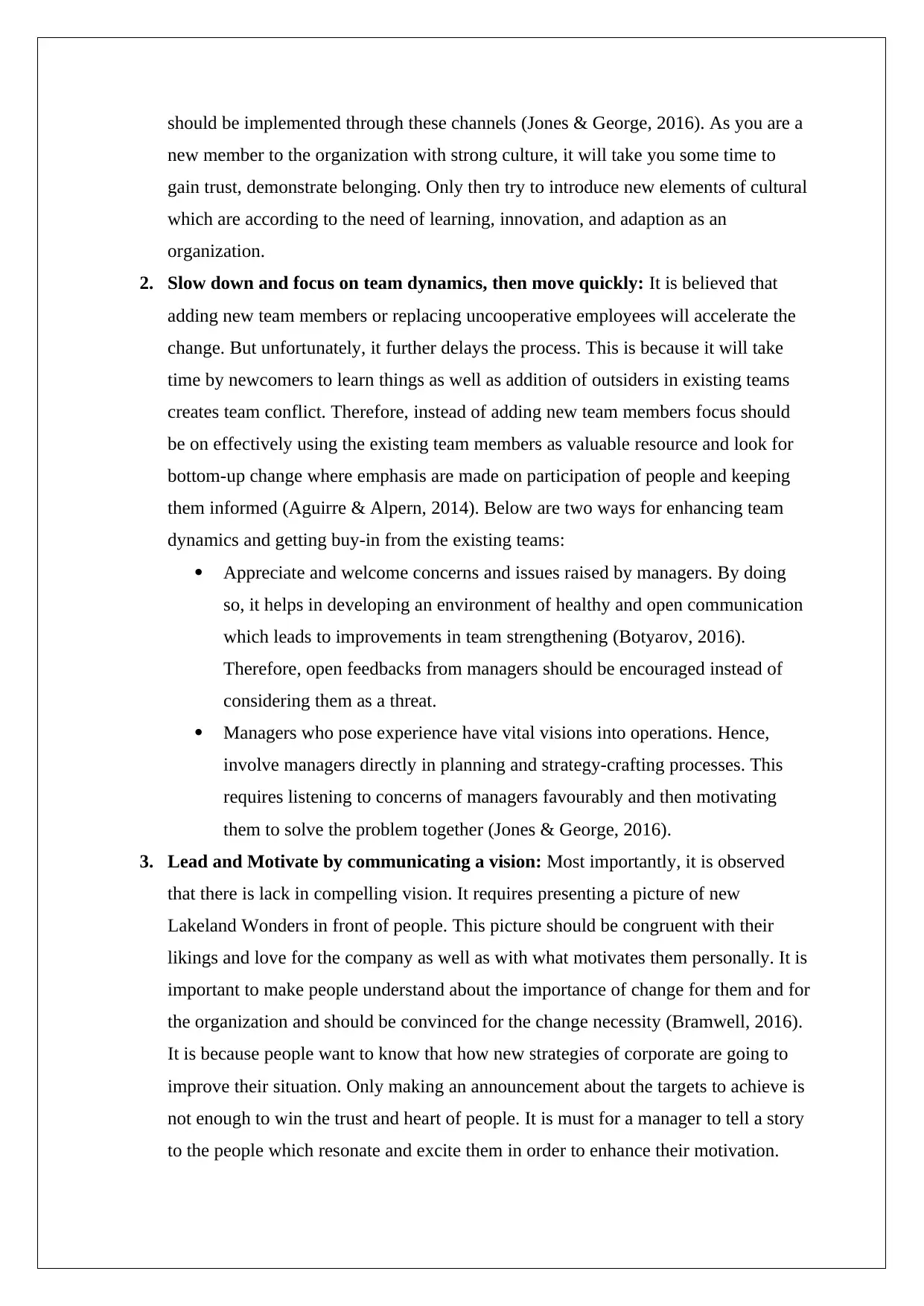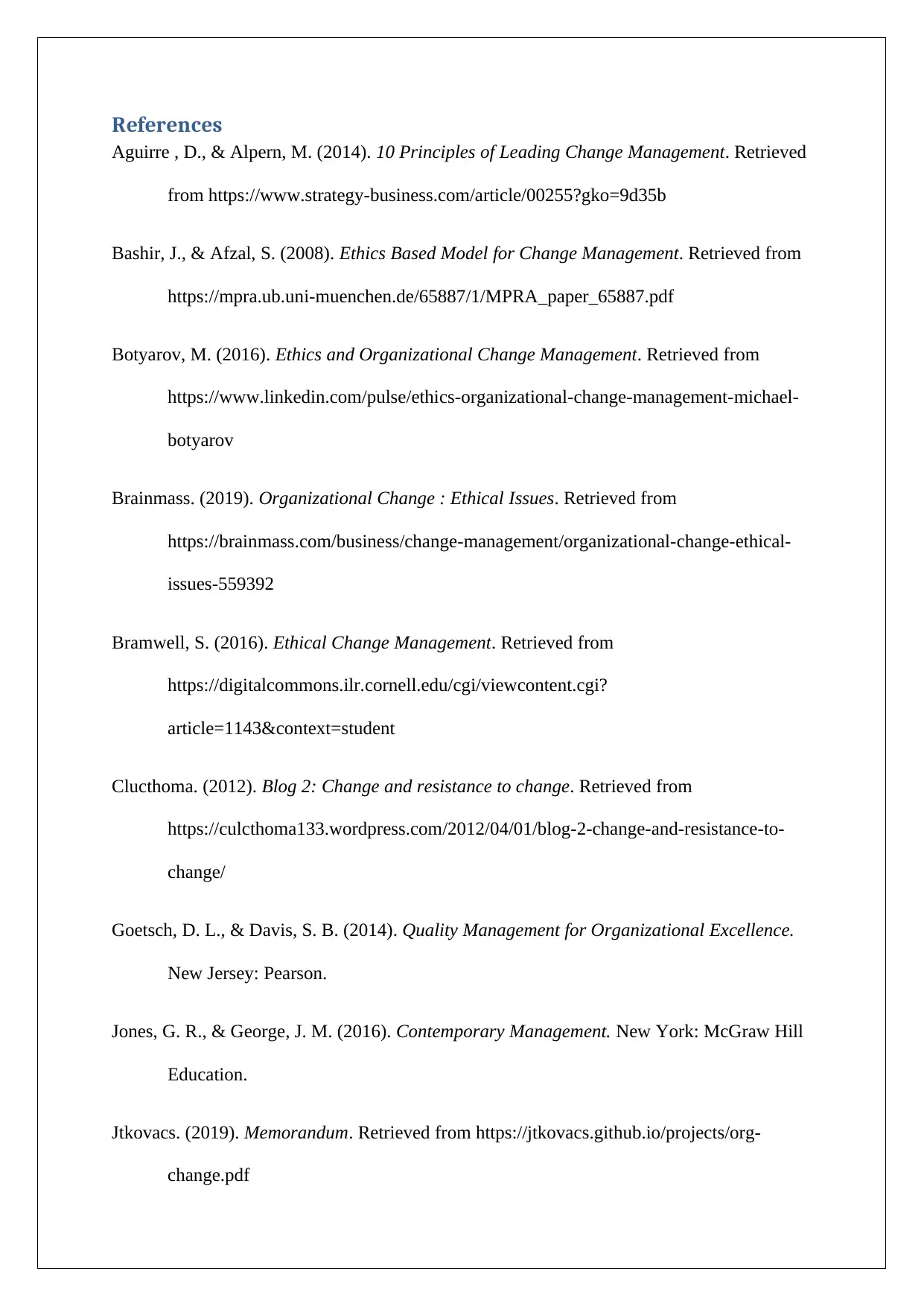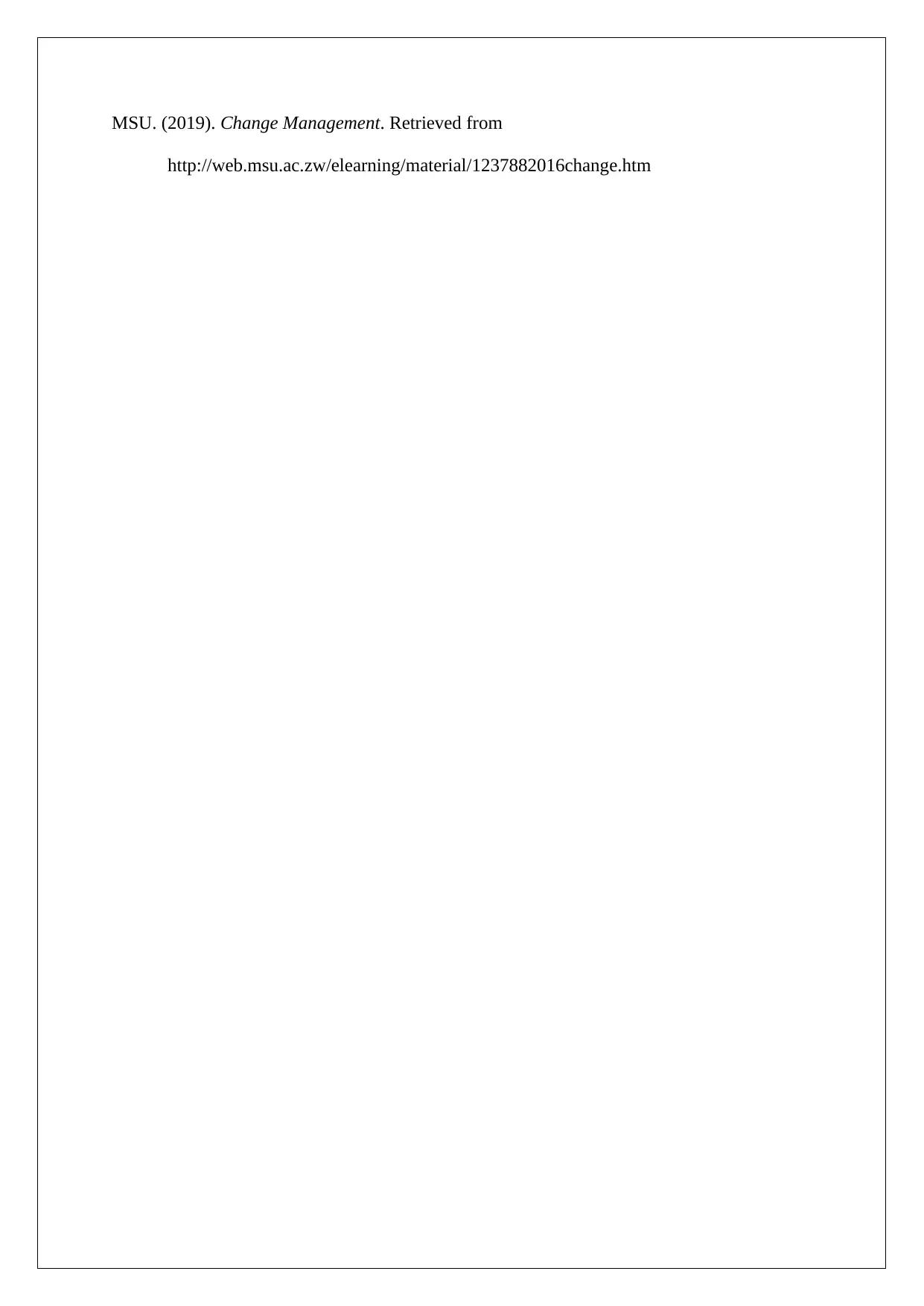Recommendations for Change Management at Lakeland Wonders
VerifiedAdded on 2023/01/16
|5
|1414
|80
AI Summary
This memo provides recommendations for effective change management at Lakeland Wonders, including analysis of forces opposing change and two principles of ethical change management.
Contribute Materials
Your contribution can guide someone’s learning journey. Share your
documents today.

MEMORANDUM
TO: Cheryl Hailstorm, CEO, Lakeland Wonders
FROM: Jacob Kovacs
DATE: April 04, 2019
SUBJECT: Recommendations for change management at Lakeland Wonders
Organizational changes are never easily welcomed by employees. It is always opposed. In
this case, you made your efforts to bring some changes in the organization in order to make
Lakeland Wonders to produce cheaper and good quality toys offshore. But, it has been seen
that changes made by you are facing huge internal opposition from many managers. Some
managers have directly raised their voice against changes and some of them are making
delays in following your instructions (Clucthoma, 2012). This memo consists of analysis
conducted to understand the reasons and causes behind resistance from mangers and proposes
some recommendations for effective change management going forward.
Analysis: Forces Opposing Change
It has been 94 years to Lakeland Wonders. Since so many years of its functionality, it is
owned by a single family whose strong leadership embedded a culture of loyalty, stability,
and pride in high-quality work. But with time it is felt by many managers that stability is
causing hindrance for the company’s growth and there is need of taking some risks for the
sake of innovation. When managers are asked to change their way of dealings with union,
employees, and regional business partners in such a way that would be destructive and unfair
for the valued relationships, loyalty becomes a force of opposition (Brainmass, 2019).
Craftspeople are asked to create mass-market products or inclusion of these products under
company’s brand causing opposition of pride.
Two Principles of Ethical Change Management
Everyone has their personal beliefs and morals but when one is at the position of a manger
where you have to guide and lead people then it is required to put your personal thoughts
aside and analyse each situation objectively in order to make most possible ethical decisions
TO: Cheryl Hailstorm, CEO, Lakeland Wonders
FROM: Jacob Kovacs
DATE: April 04, 2019
SUBJECT: Recommendations for change management at Lakeland Wonders
Organizational changes are never easily welcomed by employees. It is always opposed. In
this case, you made your efforts to bring some changes in the organization in order to make
Lakeland Wonders to produce cheaper and good quality toys offshore. But, it has been seen
that changes made by you are facing huge internal opposition from many managers. Some
managers have directly raised their voice against changes and some of them are making
delays in following your instructions (Clucthoma, 2012). This memo consists of analysis
conducted to understand the reasons and causes behind resistance from mangers and proposes
some recommendations for effective change management going forward.
Analysis: Forces Opposing Change
It has been 94 years to Lakeland Wonders. Since so many years of its functionality, it is
owned by a single family whose strong leadership embedded a culture of loyalty, stability,
and pride in high-quality work. But with time it is felt by many managers that stability is
causing hindrance for the company’s growth and there is need of taking some risks for the
sake of innovation. When managers are asked to change their way of dealings with union,
employees, and regional business partners in such a way that would be destructive and unfair
for the valued relationships, loyalty becomes a force of opposition (Brainmass, 2019).
Craftspeople are asked to create mass-market products or inclusion of these products under
company’s brand causing opposition of pride.
Two Principles of Ethical Change Management
Everyone has their personal beliefs and morals but when one is at the position of a manger
where you have to guide and lead people then it is required to put your personal thoughts
aside and analyse each situation objectively in order to make most possible ethical decisions
Secure Best Marks with AI Grader
Need help grading? Try our AI Grader for instant feedback on your assignments.

(Jtkovacs, 2019). From analysis of Lakeland Wonders case, two principles of ethical change
management have been identified from Kotter’s study which is as follows:
1. Establishing a sense of urgency: In Lakeland Wonders case it is identified that
people are not dissatisfied with current situation of company except Hailstorm. It is
known to Hailstorm that the annual growth target of company can be achieved
through Hastings, Curtiss pressure (MSU, 2019). But, she failed to create a sense of
urgency among employees and management that marketing position of company need
expansion in order to earn more revenue.
2. Develop and Communicate a Clear Change Vision: In this case, however
Hailstorm drew a vision for the company but she failed in sharing her vision with
Swensen family board members and senior management (Bashir & Afzal, 2008).
In this case, it is observed that hailstorm did not provide necessary evidence to senior vice
president, Mark Dawson, so that he believes in her change model. This created conflict
between two of them. According to Hailstorm’s vision for entering the middle toy market,
Lakeland needed to cut down its cost and thus Hailstorm choose production line to set up
offshore but did not provide evidences of this model to Mark Dawson. Also, Hailstorm
wanted to replace the current local packaging company with newer one (Bramwell, 2016).
But, she did not provide clear explanation regarding her view on this issue.
Hailstorm plan of offshore manufacture lines will let many union workers to lose their job
opportunities. Also, if Hailstorm allows Barry Quince, design director to work with the new
packaging company then it will cause Barry to lose working relationships and negotiating
power from previous work experience (Goetsch & Davis, 2014).
Recommendations
1. Consider it as a Cultural Issue and appreciate its magnitude: When opposition is
in the roots of organization’s culture then the strategies for managing with incentive
pay and leading by example will not meet the requirements. Since culture of an
organization is formed from leaders’ and founders’ values, shared rituals, employee
socialization, and stories, cultural change such as changes in strategy and operations
management have been identified from Kotter’s study which is as follows:
1. Establishing a sense of urgency: In Lakeland Wonders case it is identified that
people are not dissatisfied with current situation of company except Hailstorm. It is
known to Hailstorm that the annual growth target of company can be achieved
through Hastings, Curtiss pressure (MSU, 2019). But, she failed to create a sense of
urgency among employees and management that marketing position of company need
expansion in order to earn more revenue.
2. Develop and Communicate a Clear Change Vision: In this case, however
Hailstorm drew a vision for the company but she failed in sharing her vision with
Swensen family board members and senior management (Bashir & Afzal, 2008).
In this case, it is observed that hailstorm did not provide necessary evidence to senior vice
president, Mark Dawson, so that he believes in her change model. This created conflict
between two of them. According to Hailstorm’s vision for entering the middle toy market,
Lakeland needed to cut down its cost and thus Hailstorm choose production line to set up
offshore but did not provide evidences of this model to Mark Dawson. Also, Hailstorm
wanted to replace the current local packaging company with newer one (Bramwell, 2016).
But, she did not provide clear explanation regarding her view on this issue.
Hailstorm plan of offshore manufacture lines will let many union workers to lose their job
opportunities. Also, if Hailstorm allows Barry Quince, design director to work with the new
packaging company then it will cause Barry to lose working relationships and negotiating
power from previous work experience (Goetsch & Davis, 2014).
Recommendations
1. Consider it as a Cultural Issue and appreciate its magnitude: When opposition is
in the roots of organization’s culture then the strategies for managing with incentive
pay and leading by example will not meet the requirements. Since culture of an
organization is formed from leaders’ and founders’ values, shared rituals, employee
socialization, and stories, cultural change such as changes in strategy and operations

should be implemented through these channels (Jones & George, 2016). As you are a
new member to the organization with strong culture, it will take you some time to
gain trust, demonstrate belonging. Only then try to introduce new elements of cultural
which are according to the need of learning, innovation, and adaption as an
organization.
2. Slow down and focus on team dynamics, then move quickly: It is believed that
adding new team members or replacing uncooperative employees will accelerate the
change. But unfortunately, it further delays the process. This is because it will take
time by newcomers to learn things as well as addition of outsiders in existing teams
creates team conflict. Therefore, instead of adding new team members focus should
be on effectively using the existing team members as valuable resource and look for
bottom-up change where emphasis are made on participation of people and keeping
them informed (Aguirre & Alpern, 2014). Below are two ways for enhancing team
dynamics and getting buy-in from the existing teams:
Appreciate and welcome concerns and issues raised by managers. By doing
so, it helps in developing an environment of healthy and open communication
which leads to improvements in team strengthening (Botyarov, 2016).
Therefore, open feedbacks from managers should be encouraged instead of
considering them as a threat.
Managers who pose experience have vital visions into operations. Hence,
involve managers directly in planning and strategy-crafting processes. This
requires listening to concerns of managers favourably and then motivating
them to solve the problem together (Jones & George, 2016).
3. Lead and Motivate by communicating a vision: Most importantly, it is observed
that there is lack in compelling vision. It requires presenting a picture of new
Lakeland Wonders in front of people. This picture should be congruent with their
likings and love for the company as well as with what motivates them personally. It is
important to make people understand about the importance of change for them and for
the organization and should be convinced for the change necessity (Bramwell, 2016).
It is because people want to know that how new strategies of corporate are going to
improve their situation. Only making an announcement about the targets to achieve is
not enough to win the trust and heart of people. It is must for a manager to tell a story
to the people which resonate and excite them in order to enhance their motivation.
new member to the organization with strong culture, it will take you some time to
gain trust, demonstrate belonging. Only then try to introduce new elements of cultural
which are according to the need of learning, innovation, and adaption as an
organization.
2. Slow down and focus on team dynamics, then move quickly: It is believed that
adding new team members or replacing uncooperative employees will accelerate the
change. But unfortunately, it further delays the process. This is because it will take
time by newcomers to learn things as well as addition of outsiders in existing teams
creates team conflict. Therefore, instead of adding new team members focus should
be on effectively using the existing team members as valuable resource and look for
bottom-up change where emphasis are made on participation of people and keeping
them informed (Aguirre & Alpern, 2014). Below are two ways for enhancing team
dynamics and getting buy-in from the existing teams:
Appreciate and welcome concerns and issues raised by managers. By doing
so, it helps in developing an environment of healthy and open communication
which leads to improvements in team strengthening (Botyarov, 2016).
Therefore, open feedbacks from managers should be encouraged instead of
considering them as a threat.
Managers who pose experience have vital visions into operations. Hence,
involve managers directly in planning and strategy-crafting processes. This
requires listening to concerns of managers favourably and then motivating
them to solve the problem together (Jones & George, 2016).
3. Lead and Motivate by communicating a vision: Most importantly, it is observed
that there is lack in compelling vision. It requires presenting a picture of new
Lakeland Wonders in front of people. This picture should be congruent with their
likings and love for the company as well as with what motivates them personally. It is
important to make people understand about the importance of change for them and for
the organization and should be convinced for the change necessity (Bramwell, 2016).
It is because people want to know that how new strategies of corporate are going to
improve their situation. Only making an announcement about the targets to achieve is
not enough to win the trust and heart of people. It is must for a manager to tell a story
to the people which resonate and excite them in order to enhance their motivation.

References
Aguirre , D., & Alpern, M. (2014). 10 Principles of Leading Change Management. Retrieved
from https://www.strategy-business.com/article/00255?gko=9d35b
Bashir, J., & Afzal, S. (2008). Ethics Based Model for Change Management. Retrieved from
https://mpra.ub.uni-muenchen.de/65887/1/MPRA_paper_65887.pdf
Botyarov, M. (2016). Ethics and Organizational Change Management. Retrieved from
https://www.linkedin.com/pulse/ethics-organizational-change-management-michael-
botyarov
Brainmass. (2019). Organizational Change : Ethical Issues. Retrieved from
https://brainmass.com/business/change-management/organizational-change-ethical-
issues-559392
Bramwell, S. (2016). Ethical Change Management. Retrieved from
https://digitalcommons.ilr.cornell.edu/cgi/viewcontent.cgi?
article=1143&context=student
Clucthoma. (2012). Blog 2: Change and resistance to change. Retrieved from
https://culcthoma133.wordpress.com/2012/04/01/blog-2-change-and-resistance-to-
change/
Goetsch, D. L., & Davis, S. B. (2014). Quality Management for Organizational Excellence.
New Jersey: Pearson.
Jones, G. R., & George, J. M. (2016). Contemporary Management. New York: McGraw Hill
Education.
Jtkovacs. (2019). Memorandum. Retrieved from https://jtkovacs.github.io/projects/org-
change.pdf
Aguirre , D., & Alpern, M. (2014). 10 Principles of Leading Change Management. Retrieved
from https://www.strategy-business.com/article/00255?gko=9d35b
Bashir, J., & Afzal, S. (2008). Ethics Based Model for Change Management. Retrieved from
https://mpra.ub.uni-muenchen.de/65887/1/MPRA_paper_65887.pdf
Botyarov, M. (2016). Ethics and Organizational Change Management. Retrieved from
https://www.linkedin.com/pulse/ethics-organizational-change-management-michael-
botyarov
Brainmass. (2019). Organizational Change : Ethical Issues. Retrieved from
https://brainmass.com/business/change-management/organizational-change-ethical-
issues-559392
Bramwell, S. (2016). Ethical Change Management. Retrieved from
https://digitalcommons.ilr.cornell.edu/cgi/viewcontent.cgi?
article=1143&context=student
Clucthoma. (2012). Blog 2: Change and resistance to change. Retrieved from
https://culcthoma133.wordpress.com/2012/04/01/blog-2-change-and-resistance-to-
change/
Goetsch, D. L., & Davis, S. B. (2014). Quality Management for Organizational Excellence.
New Jersey: Pearson.
Jones, G. R., & George, J. M. (2016). Contemporary Management. New York: McGraw Hill
Education.
Jtkovacs. (2019). Memorandum. Retrieved from https://jtkovacs.github.io/projects/org-
change.pdf
Secure Best Marks with AI Grader
Need help grading? Try our AI Grader for instant feedback on your assignments.

MSU. (2019). Change Management. Retrieved from
http://web.msu.ac.zw/elearning/material/1237882016change.htm
http://web.msu.ac.zw/elearning/material/1237882016change.htm
1 out of 5
Your All-in-One AI-Powered Toolkit for Academic Success.
+13062052269
info@desklib.com
Available 24*7 on WhatsApp / Email
![[object Object]](/_next/static/media/star-bottom.7253800d.svg)
Unlock your academic potential
© 2024 | Zucol Services PVT LTD | All rights reserved.
